You don’t need a large garden to have freshly picked fruit in the summer. Many types of fruit plants do well in containers, making them ideal for small yards, patios, and even balconies.
Let’s take a look at how to get started with container gardening, and dive into the top 12 best fruits you can grow in containers.

What Are the Benefits of Container Gardening?
Container gardening simply means growing plants in pots. Besides saving space, this type of gardening offers many advantages for gardeners. Some of these include:
- Very little to no weeding. Unlike a large garden, it’s unlikely seeds from weeds will blow into your pots. And if they do, it’s easy to remove them.
- More variety. You can grow plants right next to each other that normally wouldn’t be compatible. And you can control the type of soil you use.
- Flexibility. You can change the look of your garden by easily moving plants around.
- Saves your back. Containers can be placed on tables or high surfaces. Even people with limited mobility can care for the plants.
How to Get Started On Your Container Garden
Container gardening is easy and convenient, but you do want to put some thought into it before you get started. Depending on what you are planting, you need to consider the following factors.
Choose the right container.
There are many choices in containers, but the number one factor to consider is proper drainage. Soggy roots will kill a plant. If the container you want to use doesn’t have drainage, simply drill small holes or line the bottom of the pot with a few inches of broken terracotta and small stones.
Aside from drainage, you also need to check the size requirements of your plant and be sure to choose a container that is the correct size. Plants need room for their roots, and a too-small container will limit their growth.
Use the right kind of soil.
Potting mixes are made especially for use with potted plants. Potting mix soil is made to be looser, full of nutrients, and has better drainage than soil from your garden. Additionally, regular garden soil lacks the moisture control and other features you need to grow healthy plants in a pot.
Fertilizer for your container plants.
You may not need to add fertilizer when planting if your soil comes with added fertilizer. But after a few weeks, it’s a good idea to apply a liquid fertilizer. These are easy to use and the liquid will get the nutrients right to where your plant needs them, at the roots.
Caring for Container Plants
Container plants aren’t hard to care for, but you can follow these tips to keep your garden thriving.

Larger pests, such as slugs, can be picked off by hand.
©iStock.com/1284919455
Water regularly.
You may need to water every day during the summer. Because the roots are in a small, compact area, they can only get so much water each day. In cooler weather, you may not need to water every day. Be sure to can keep an eye on the moisture level. Stick your finger in the soil up to your knuckle. If it’s dry, you need to water it. If it’s moist, you can wait a day and check again.
Prune your plants.
If your plants begin to look overgrown, pull out the pruning shears and tidy them up. However, some fruit trees only should be pruned only when the tree is dormant (fall or spring.) Follow the care guide for your plant before you pull out the pruning shears.
Control pests.
Healthy, fertilized, and well-watered plants will be less susceptible to pests and disease. Yet, pests can still strike at any time, so it’s a good idea to check your plants each day. Catching issues early will make getting rid of them much easier. Larger pests, such as slugs, can be picked off by hand. You can also use an organic pesticide such as neem oil, insecticidal soap, garlic spray, or hot pepper spray.
Now that we’ve covered the basics, let’s take a look at the 12 best types of fruits that work well in containers.
1: Strawberries
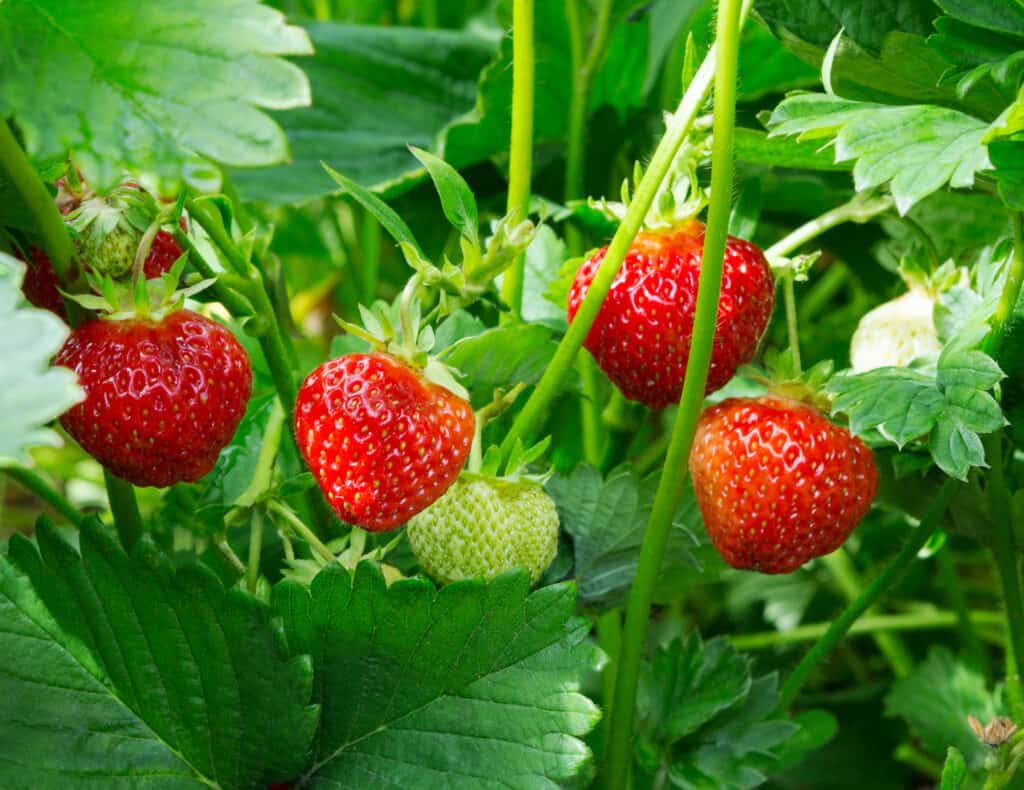
Strawberries are an ideal plant to grow in pots.
©iStock.com/romiri
First on the list, strawberries are an ideal plant to grow in pots. Although they’re small and fit easily in most containers, they will bear the most fruit when they aren’t overcrowded. Only fit three to four strawberry plants per square root of soil.
Keep an eye out for what type of strawberry plant you choose. June-bearing will bear fruit once per season, while ever-bearing will produce two crops per summer.
- Size: 4 to 12 inches tall
- Sun Exposure: Full sun
- Soil Requirements: Sandy, slightly acidic
2: Blueberries

Whether you’re growing blueberries in the ground or in a pot they take a few years to mature.
©Maria Dryfhout/Shutterstock.com
Even if you have the space for blueberry shrubs in the ground, you may want to consider planting them in pots. Blueberries need acidic soil, which is easier to control in garden pots. Keep in mind, whether you’re growing blueberries in the ground or in a pot they take a few years to mature. It will be a couple of growing seasons before a blueberry plant will bear fruit.
- Size: 24 inches to 4 feet
- Sun Exposure: Full sun
- Soil Requirements: Sandy, acidic, well-drained
3: Gooseberries
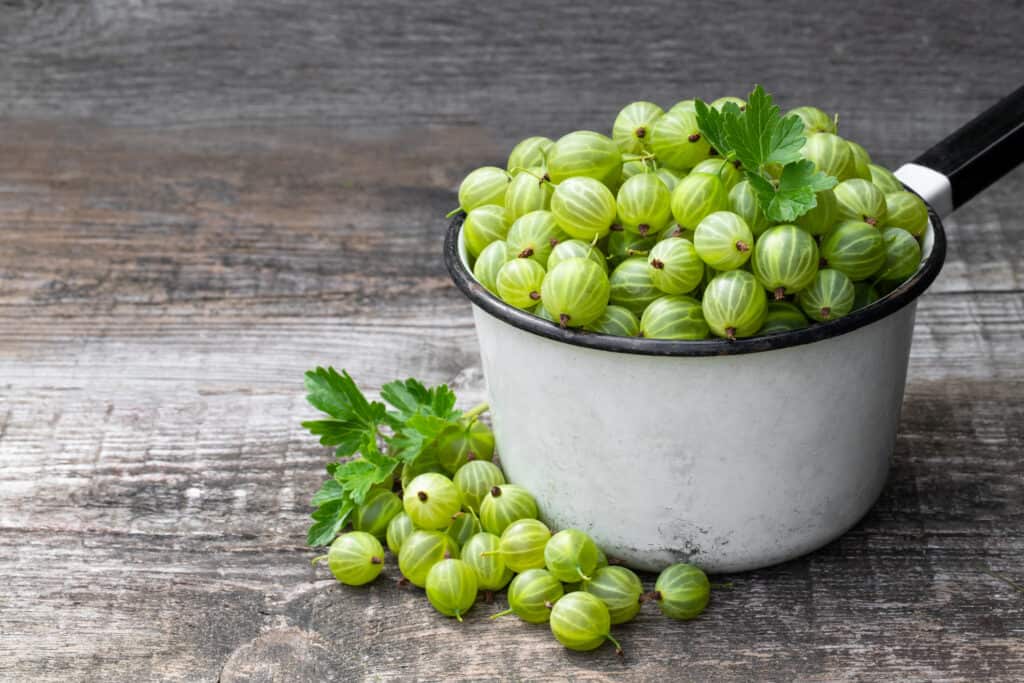
Gooseberries are used when making jams and sauces.
©iStock.com/Lena_Zajchikova
Another berry that does well in pots is the gooseberry. If you are unfamiliar with the gooseberry, its tartness does well in baking pies and jams. Gooseberries grow best in cool regions. If planting them in a hot summer environment, plant them in partial shade.
- Size: 3 to 5 feet tall
- Sun Exposure: Full sun (in hot regions – partial shade.)
- Soil Requirements: Slightly acidic, well-drained
4: Apples
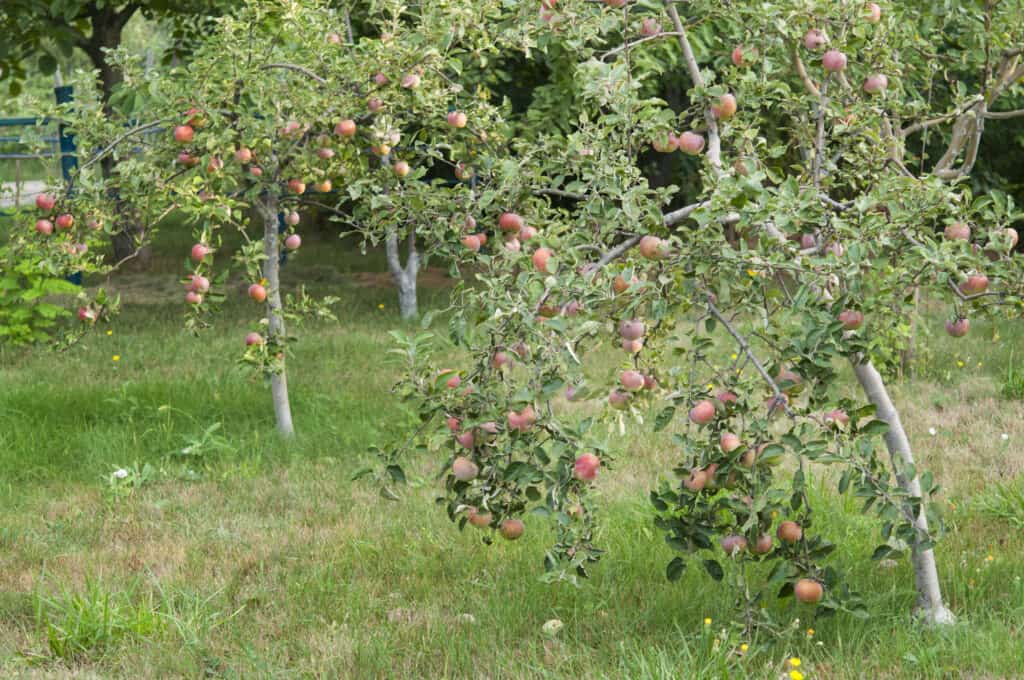
Dwarf apples are a perfect size for containers.
©iStock.com/np-e07
You may not think of apples as a fruit you can grow in pots, but dwarf apples are a perfect size for containers. There is one thing to keep in mind when choosing an apple tree. Some plants are self-fertilizing, but some require another plant nearby to cross-pollinate. Even self-fertilizing plants will often do better when cross-pollinated.
- Size: 4 to 6 feet tall
- Sun Exposure: Full sun
- Soil Requirements: Acidic to neutral, sandy loam, well-drained
5: Cherries
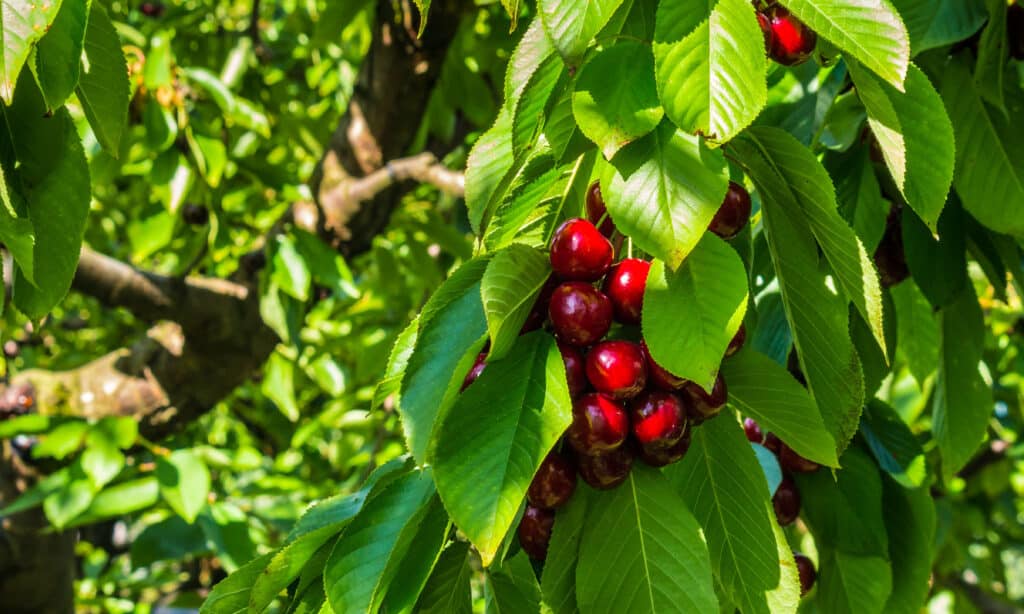
Like apples, check your variety because some require another cherry tree nearby for cross-pollination.
©patjo/Shutterstock.com
Cherry trees are another type of plant that can do well in small spaces, such as containers. Like apples, check your variety because some require another cherry tree nearby for cross-pollination. Also, dwarf varieties will fit better in small areas.
- Size: 6.5 to 8 feet tall
- Sun Exposure: Full sun
- Soil Requirements: Fertile, slightly acidic, well-drained
6: Figs
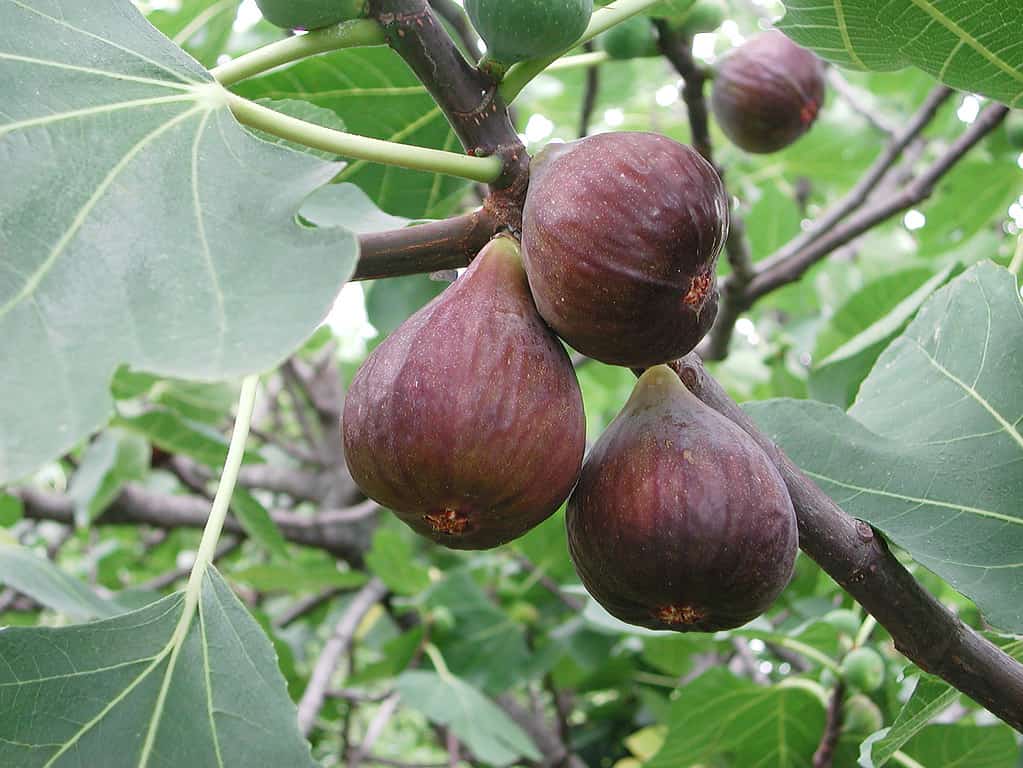
Most gardeners find their fig trees stay around six to eight feet tall when grown in pots.
©simona pavan/Shutterstock.com
This tropical fruit is a small shrub or tree that can easily be grown in containers. Growing figs in pots works well in colder climates because the plant can be moved indoors during its dormant period to avoid harsh, winter weather. Fig trees in the ground can reach 10 to 20 feet in height. But most gardeners find their fig trees stay around six to eight feet tall when grown in pots.
- Size: 6 to 8 feet tall
- Sun Exposure: Full sun
- Soil Requirements: Fertile, slightly acidic, well-drained, nutrient-rich
7: Plums
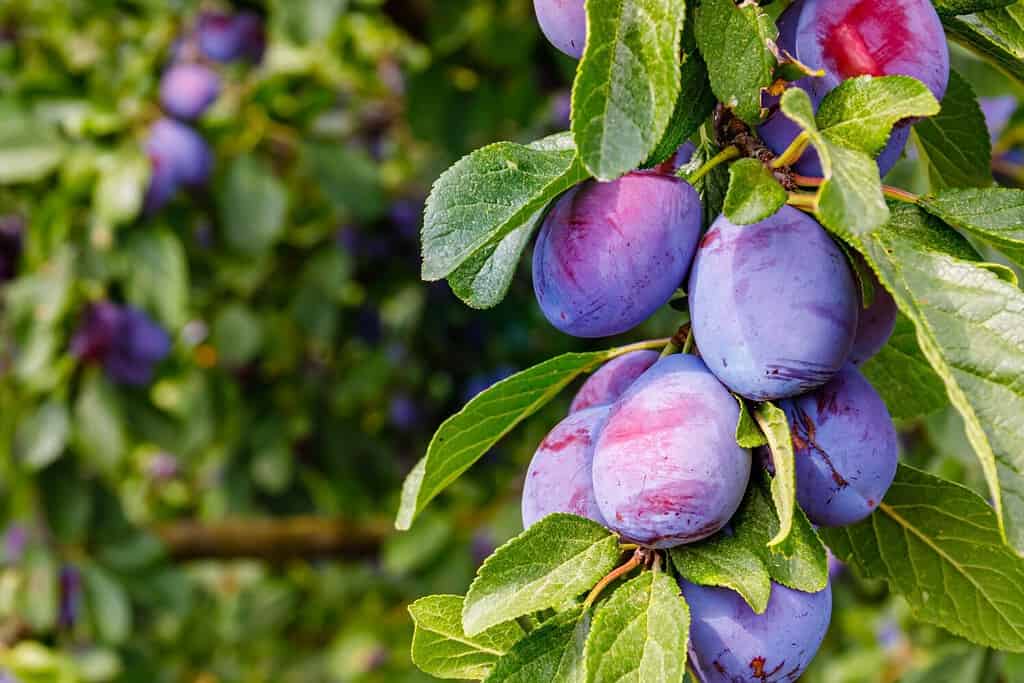
The dwarf variety will provide a full crop of fruit in a more compact size than planting a full-size tree in your yard.
©nnattalli/Shutterstock.com
Dwarf plum trees thrive in smaller growing spaces, making them another ideal selection for container gardening. The dwarf variety will provide a full crop of fruit in a more compact size than planting a full-size tree in your yard. Another benefit, plum trees have sweet-smelling blooms in the spring.
- Size: 6 to 8 feet tall
- Sun Exposure: Full sun
- Soil Requirements: Loamy, well-drained
8: Olives

Olive trees are not hardy and will need to be moved inside during winter and brought back out after the last freeze date.
©jessicahyde/Shutterstock.com
You may not think of olives as a fruit due to their savory taste, but they contain a seed and grow from the flower of a plant. Some olive trees are ornamental and never bear fruit. If you’re looking to harvest olives, be sure to choose a cultivar that produces the fruit. Olive trees are not hardy and will need to be moved inside during winter and brought back out after the last freeze date.
- Size: 6 to 10 feet tall
- Sun Exposure: Full sun
- Soil Requirements: Acidic or alkaline, rocky, well-drained
9: Peaches

Growing your peach tree in containers where you can keep it inside during cold snaps is an ideal way to grow.
©Crisp0022/Shutterstock.com
Peach trees begin blooming in March, but a frost will kill the tree in colder climates. Growing your peach tree in containers where you can keep it inside during cold snaps is an ideal way to grow peach trees in areas with cold winters. There are many dwarf varieties to choose from that will fit well in pots.
- Size: 8 to 10 feet tall
- Sun Exposure: Full sun
- Soil Requirements: Clay, peat, or loam-based
10: Lemons
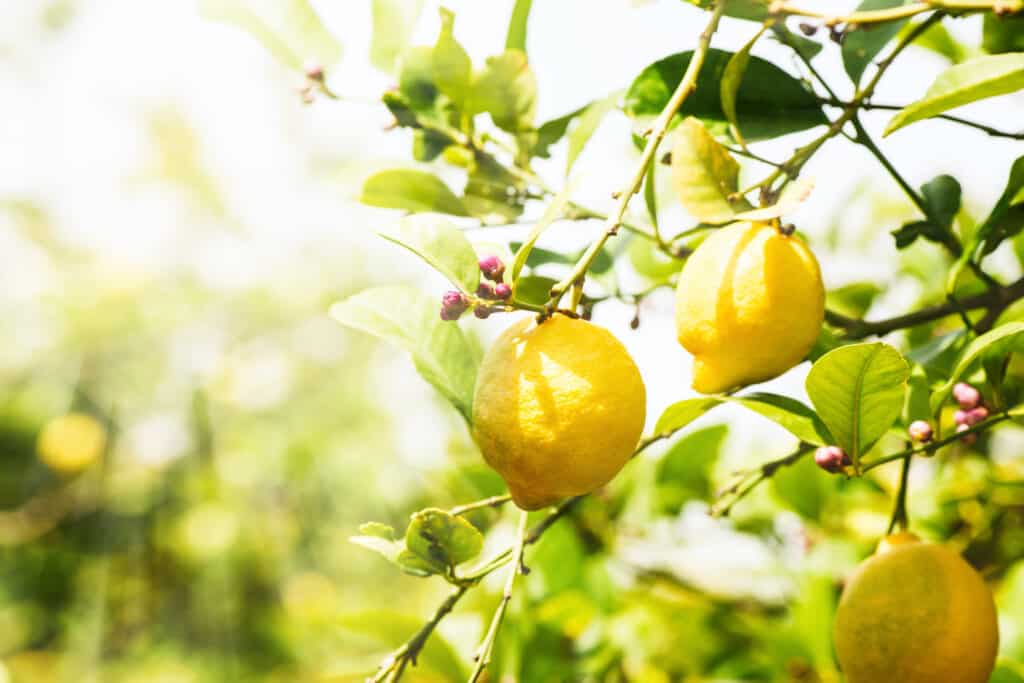
Bring them inside when the weather begins to grow cold unless you live in a warm enough climate.
©iStock.com/Denira777
You don’t have to live in the tropics to enjoy the pleasure of picking a fresh lemon off the tree in your own backyard. Lemon trees can thrive in containers in colder regions. Bring them inside when the weather begins to grow cold unless you live in a warm enough climate to leave them outside year-round.
- Size: 6 to 12 feet tall
- Sun Exposure: Full sun
- Soil Requirements: rich, sandy loam, well-drained
11: Raspberries
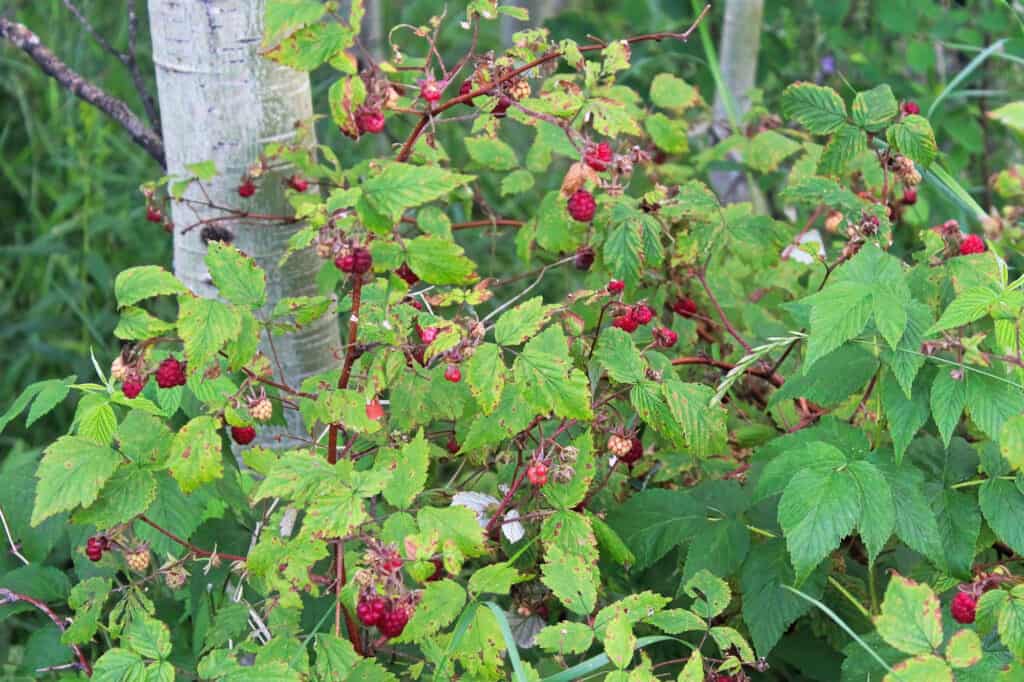
Raspberries are great for containers because you can control invasive spreading and easily control the nutrient level of your soil.
©Amelia Martin/Shutterstock.com
Raspberries are great for containers because you can control invasive spreading and easily control the nutrient level of your soil. Some varieties are too large for containers but dwarf varieties are much smaller and are perfect for a container garden, letting you enjoy delicious, juicy berries all summer.
- Size: 2 to 3 feet tall
- Sun Exposure: Full sun
- Soil Requirements: Slightly acidic, rich, well-draining
12: Pomegranates
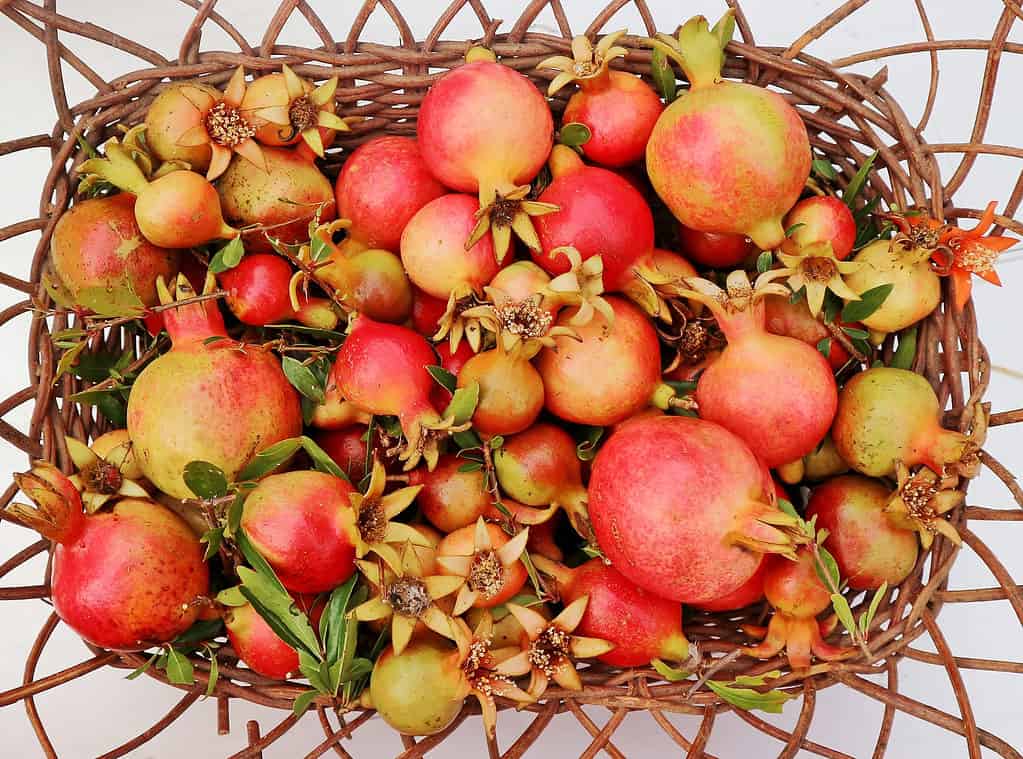
One benefit of pomegranates is that they are a self-pollinating tree.
©luca pbl/Shutterstock.com
Pomegranates thrive in warm, dry climates, but you can grow them yourself with container gardening. Pomegranates can either be kept indoors year-round or only brought outside during warm summer months. One benefit of pomegranates is that they are a self-pollinating tree. You will only need to keep one to bear fruit.
- Size: 5 to 6 feet tall
- Sun Exposure: Full sun
- Soil Requirements: Deep loamy, moderately acidic to slightly alkaline, well-drained
Summary of the 12 Best Fruits to Grow in Containers
| Plant | Size | Sun Exposure | Soil Requirements |
|---|---|---|---|
| Strawberries | 4 – 12″ tall | Full sun | Sandy, slightly acidic |
| Blueberries | 24″ to 4′ tall | Full sun | Sandy, acidic, well-drained |
| Gooseberries | 3′ to 5′ tall | Full sun | Slightly acidic, well-drained |
| Apples | 4′ to 6′ tall | Full sun | Acidic to neutral, sandy loam, well-drained |
| Cherries | 6.5′ to 8′ tall | Full sun | Fertile, slightly acidic, well-drained |
| Figs | 6′ to 8′ tall | Full sun | Fertile, slightly acidic, well-drained, nutrient-rich |
| Plums | 6′ to 8′ tall | Full sun | Loamy, well-drained |
| Olives | 6′ to 10′ tall | Full sun | Acidic or alkaline, rocky, well-drained |
| Peaches | 8′ to 10′ tall | Full sun | Clay, peat, or loam-based |
| Lemons | 6′ to 12′ tall | Full sun | Rich, sandy loam, well-drained |
| Raspberries | 2′ to 3′ tall | Full sun | Slightly acidic, rich, well-draining |
| Pomegranates | 5 to 6′ tall | Full sun | Loamy, moderately acidic, slightly alkaline, well-drained |
The photo featured at the top of this post is © sophiecat/Shutterstock.com
Thank you for reading! Have some feedback for us? Contact the AZ Animals editorial team.






